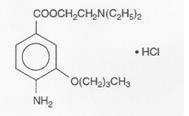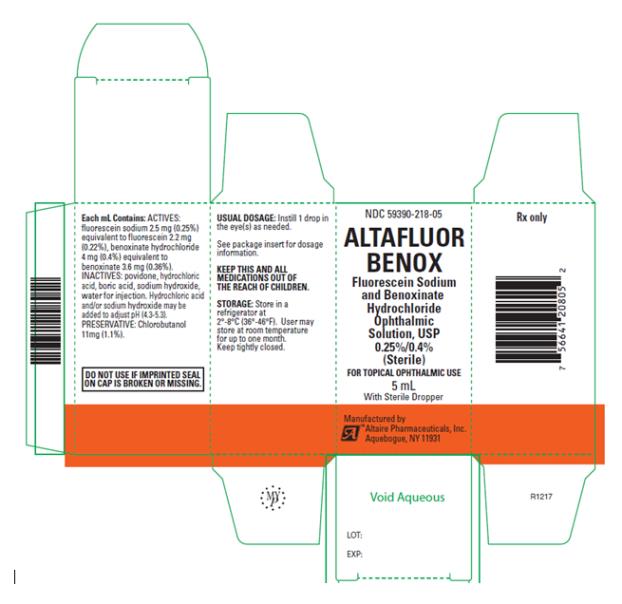ALTAFLUOR- fluorescein sodium and benoxinate hydrochloride solution
Altaire Pharmaceuticals Inc.
----------
HIGHLIGHTS OF PRESCRIBING INFORMATIONThese highlights do not include all the information needed to use Fluorescein Sodium and Benoxinate Hydrochloride Ophthalmic Solution USP, 0.25%/0.4% safely and effectively. See full prescribing information for Fluorescein Sodium and Benoxinate Hydrochloride Ophthalmic Solution USP, 0.25%/0.4%.
FLUORESCEIN SODIUM AND BENOXINATE HYDROCHLORIDE OPHTHALMIC SOLUTION USP, 0.25%/0.4% (STERILE) Initial U.S. Approval: 2017 INDICATIONS AND USAGEFor procedures requiring a disclosing agent in combination with a topical ophthalmic anesthetic agent such as tonometry, gonioscopy, removal of corneal foreign bodies and other short corneal or conjunctival procedures [1]. DOSAGE AND ADMINISTRATIONUsual Dosage: Removal of foreign bodies and sutures, and for tonometry, 1 to 2 drops (in single instillations) in each eye before operating. Deep Ophthalmic Anesthesia: Two drops in each eye at 90 second intervals for three instillations. Note: Because the “blink” reflex is temporarily eliminated, it is suggested that the eye be covered with a patch following this procedure [2]. DOSAGE FORMS AND STRENGTHS0.25%/0.4% sterile ophthalmic solution [3]. CONTRAINDICATIONSKnown hypersensitivity to any component of this product [4]. WARNINGS AND PRECAUTIONSNot for injection. Topical ophthalmic use only [5.1]. Prolonged use of a topical ocular anesthetic is not recommended. It may produce permanent corneal opacification with accompanying visual loss [5.2]. This product should be used cautiously and sparingly in patients with known allergies, cardiac disease, or hyperthyroidism [5.3]. The long-term toxicity is unknown; prolonged use may possibly delay wound healing [5.4]. Although exceedingly rare with ophthalmic application of local anesthetics, it should be borne in mind that systemic toxicity manifested by central nervous system stimulation followed by depression may occur [5.5]. Protection of the eye from irritation, chemicals, foreign bodies and rubbing during the period of anesthesia is very important. Patients should be advised to avoid touching the eye until the anesthesia has worn off [5.6]. Tonometers soaked in sterilizing or detergent solutions should be thoroughly rinsed with sterile distilled water prior to use [5.7]. ADVERSE REACTIONSOccasional temporary stinging, burning and conjunctival redness have been reported after use of ocular anesthetics, as well as a rare, severe, immediate-type, apparent hyper-allergic corneal reaction, with acute, intense and diffuse epithelial keratitis, a gray ground glass appearance, sloughing of large areas of necrotic epithelium, corneal filaments and sometimes, iritis with descemetitis. Allergic contact dermatitis with drying and fissuring of the fingertips has been reported [6].
See 17 for PATIENT COUNSELING INFORMATION. Revised: 2/2017 |
FULL PRESCRIBING INFORMATION: CONTENTS*1. INDICATIONS AND USAGE:2. DOSAGE AND ADMINISTRATION:3. DOSAGE FORMS AND STRENGTHS:4. CONTRAINDICATIONS:5. WARNINGS AND PRECAUTIONS5.1 Topical Ophthalmic Use Only5.2 Avoid Prolonged Use5.3 Use Sparingly5.4 Long Term Toxicity5.5 Systemic Toxicity5.6 Protection of Eye During Anesthesia5.7 Interaction with Tonometer Cleaning Agents6. ADVERSE REACTIONS:8. USE IN SPECIFIC POPULATIONS8.1 Pregnancy:8.2 Lactation:8.4 Pediatric Use:11. DESCRIPTION12. CLINICAL PHARMACOLOGY16. HOW SUPPLIED/STORAGE AND HANDLING:17. PATIENT COUNSELING INFORMATION
|
FULL PRESCRIBING INFORMATION
1. INDICATIONS AND USAGE:
For procedures requiring a disclosing agent in combination with a topical ophthalmic anesthetic agent such as tonometry, gonioscopy, removal of corneal foreign bodies and other short corneal or conjunctival procedures.
2. DOSAGE AND ADMINISTRATION:
Usual Dosage: Removal of foreign bodies and sutures, and for tonometry: 1 to 2 drops (in single instillations) in each eye before operating.
Deep Ophthalmic Anesthesia: Two drops in each eye at 90 second intervals for three instillations.
Note: Because the “blink” reflex is temporarily eliminated, it is suggested that the eye be covered with a patch following this procedure.
3. DOSAGE FORMS AND STRENGTHS:
Fluorescein Sodium and Benoxinate Hydrochloride Ophthalmic Solution USP, 0.25%/0.4% is a yellow to orange-red mobile solution (strongly fluorescent) containing Fluorescein Sodium 0.25% and Benoxinate Hydrochloride 0.4%.
5. WARNINGS AND PRECAUTIONS
5.1 Topical Ophthalmic Use Only
Fluorescein Sodium and Benoxinate Hydrochloride Ophthalmic Solution USP, 0.25%/0.4% is not indicated for injection.
5.2 Avoid Prolonged Use
Prolonged use of a topical ocular anesthetic is not recommended. It may produce permanent corneal opacification with accompanying visual loss.
5.3 Use Sparingly
This product should be used cautiously and sparingly in patients with known allergies, cardiac disease, or hyperthyroidism.
5.4 Long Term Toxicity
The long-term toxicity is unknown; prolonged use may possibly delay wound healing.
5.5 Systemic Toxicity
Although exceedingly rare with ophthalmic application of local anesthetics, it should be borne in mind that systemic toxicity manifested by central nervous system stimulation followed by depression may occur. Anaphylactic reactions have been reported with ocular administration of fluorescein although they more frequently occur with intravenous administration of fluorescein.
6. ADVERSE REACTIONS:
Occasional temporary stinging, burning and conjunctival redness have been reported after use of ocular anesthetics, as well as a rare, severe, immediate-type, apparent hyper-allergic corneal reaction, with acute, intense and diffuse epithelial keratitis, a gray ground glass appearance, sloughing of large areas of necrotic epithelium, corneal filaments and sometimes, iritis with descemetitis. Allergic contact dermatitis with drying and fissuring of the fingertips has been reported.
8. USE IN SPECIFIC POPULATIONS
8.1 Pregnancy:
Risk Summary: Fluorescein Sodium and Benoxinate Hydrochloride Ophthalmic Solution is not absorbed systemically following ophthalmic administration, and maternal use is not expected to result in fetal exposure to the drug. There are no human data that establish the presence or absence of drug-associated risk.
8.2 Lactation:
Risk Summary: Fluorescein Sodium and Benoxinate Hydrochloride Ophthalmic Solution is not absorbed systemically by the mother following ophthalmic administration, and breastfeeding is not expected to result in exposure of the child to Fluorescein Sodium and Benoxinate Hydrochloride. There are no data that assess the effects of the drugs and/or their active metabolite(s) on the breastfed child.
11. DESCRIPTION
Fluorescein Sodium and Benoxinate Hydrochloride Ophthalmic Solution USP, 0.25%/0.4% is a disclosing agent with rapid anesthetic action of short duration.
Fluorescein Sodium is represented by the following structural formula.
![The following structural formula for Fluorescein Sodium is Spiro [isobenzofuran-1 (3H),9’-9[9H] xanthene]-3-one, 3’,6’ dihydroxy, disodium salt.](/dailymed/image.cfm?name=altaflour-01.jpg&archiveid=465109)
C20H10Na2O5 Mol. Wt. 376.27
Chemical Name: Spiro [isobenzofuran-1 (3H),9’-9[9H] xanthene]-3-one, 3’,6’ dihydroxy, disodium salt.
Benoxinate Hydrochloride is represented by the following structural formula:

C17H28N2O3 • HCl Mol. Wt. 344.88
Chemical Name: 2-(Diethylamino) etyl 4-amino-3butoxybenzoate monohydrochloride.
EACH mL CONTAINS: ACTIVES: Fluorescein Sodium 2.5 mg (0.25%), Benoxinate Hydrochloride 4 mg (0.4%); INACTIVES: Povidone, Boric Acid, Water for Injection. Hydrochloric Acid may be added to adjust pH (4.3 – 5.3). PRESERVATIVE: Chlorobutanol 1.1%.
12. CLINICAL PHARMACOLOGY
This product is the combination of a disclosing agent with a rapidly acting anesthetic of short duration.
16. HOW SUPPLIED/STORAGE AND HANDLING:
Fluorescein Sodium and Benoxinate Hydrochloride Ophthalmic Solution USP, 0.25%/0.4% is supplied in a glass bottled with a sterilized dropper in the following size: 5mL
Storage: Store in refrigerator at 2°-8°C (36°-46°F). Can be stored at room temperature for up to 1 month. Keep tightly closed.
17. PATIENT COUNSELING INFORMATION
Protection of the eye from irritation, chemicals, foreign bodies and rubbing during the period of anesthesia is very important.
Patients should be advised to avoid touching the eye until the anesthesia has worn off.
| DO NOT USE IF IMPRINTED SEAL ON CAP IS BROKEN OR MISSING |
KEEP OUT OF REACH OF CHILDREN
FOR USE IN THE EYES ONLY
Rev. 02/2017
Manufactured by:
ALTAIRE Pharmaceuticals, Inc.
Aquebogue, NY 11931
| ALTAFLUOR
fluorescein sodium and benoxinate hydrochloride solution |
|||||||||||||||
|
|||||||||||||||
|
|||||||||||||||
|
|||||||||||||||
|
|||||||||||||||
|
|||||||||||||||
| Labeler - Altaire Pharmaceuticals Inc. (786790378) |
| Establishment | |||
| Name | Address | ID/FEI | Business Operations |
|---|---|---|---|
| Altaire Pharmaceuticals, Inc. | 786790378 | MANUFACTURE(59390-206) | |
